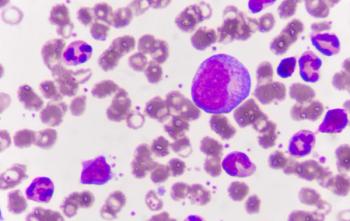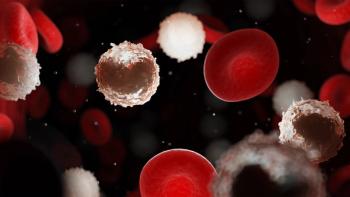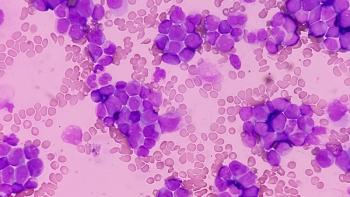
FDA Accepts 2 New Supplemental Biologics License Applications for Pembrolizumab in TNBC
Marking the first US applications for pembrolizumab in breast cancer, the applications are based on data from the KEYNOTE-355 and KEYNOTE-522 trials, respectively.
The FDA has accepted 2 new supplemental biologics license applications (sBLAs) for pembrolizumab (Keytruda) to treat certain patients with triple-negative breast cancer (TNBC), according to Merck, the developer of the agent.
The FDA has accepted and granted priority review for a new sBLA seeking accelerated approval for pembrolizumab in combination with chemotherapy for the treatment of patients with locally recurrent unresectable or metastatic TNBC whose tumors express PD-L1 (combined positive score [CPS] ≥10). The application was based on results observed in the phase 3 KEYNOTE-355 trial. A prescription drug user fee act (PDUFA) date was set by the FDA for November 28, 2020.
In addition, the FDA accepted for standard review a new sBLA for pembrolizumab for the treatment of patients with high-risk early-stage TNBC, in combination with chemotherapy as neoadjuvant treatment, and then as a single agent as adjuvant treatment after surgery, based on findings from the phase 3 KEYNOTE-522 trial. A PDUFA date for this application was set for March 29, 2021.
“There is a real need to advance new treatment options for triple-negative breast cancer, an aggressive form of the disease. The FDA’s acceptance of these [pembrolizumab] applications for review is an important step toward helping patients with both early-stage and metastatic disease,” Roy Baynes, MD, PhD, senior vice president and head of global clinical development as well as chief medical officer at Merck Research Laboratories, said in a press release. “These acceptances mark the first US applications for [pembrolizumab] in breast cancer, and we look forward to working closely with the FDA to bring these new options to patients as quickly as possible.”
In the randomized, double-blinded, phase 3 KEYNOTE-355 trial, researchers evaluated pembrolizumab in combination with 1 of 3 different chemotherapies (investigator’s choice of nab-paclitaxel, paclitaxel, or gemcitabine/carboplatin) compared with placebo plus 1 of the 3 chemotherapy regimens for the treatment of locally recurrent inoperable or metastatic TNBC. Patients were eligible to be enrolled in the trial if they had a disease-free interval of at least 6 months or were de novo metastatic.
The dual primary end points were progression-free survival (PFS) and overall survival (OS) in patients whose tumors expressed PD-L1 (CPS ≥1 and CPS ≥10) and in all participants (intention-to-treat population). Moreover, key secondary end points included objective response rate, duration of response, disease control rate, and safety.
In total, 847 patients were enrolled and randomized 2:1 to receive 200 mg of pembrolizumab every 3 weeks plus investigator’s choice of chemotherapy or placebo plus nab-paclitaxel, paclitaxel, or gemcitabine/carboplatin.
Pembrolizumab plus chemotherapy demonstrated a statistically significant and clinically meaningful improvement in PFS compared with chemotherapy alone in patients whose tumors expressed PD-L1 at CPS ≥10. Notably, approximately 38% of patients enrolled in KEYNOTE-355 had tumors expressing PD-L1 at CPS ≥10.
These data were presented at the 2020 American Society of Clinical Oncology (ASCO) Virtual Scientific Meeting. As previously announced at the meeting, the trial will continue without changes to evaluate the other dual primary end point of OS.
In the randomized, double-blinded, phase 3 KEYNOTE-522 trial, pembrolizumab was evaluated in combination with chemotherapy compared with placebo plus chemotherapy as neoadjuvant therapy, followed by pembrolizumab monotherapy compared with placebo as adjuvant therapy in patients with TNBC.
The dual primary endpoints were pathologic complete response (pCR) and event-free survival (EFS). The secondary end points included pCR rate using alternative definitions of no invasive or noninvasive residual cancer in breast or nodes at the time of definitive surgery, OS, EFS in patients whose tumors express PD-L1 (CPS ≥1), safety, and patient-reported outcomes. Researchers enrolled 1174 patients in the study and randomized them 2:1 to receive either:
- Pembrolizumab every 3 weeks plus paclitaxel weekly and carboplatin (weekly or every three weeks) for 4 cycles, followed by pembrolizumab plus cyclophosphamide and either doxorubicin or epirubicin every 3 weeks for 4 cycles as neoadjuvant therapy prior to surgery, followed by 9 cycles of pembrolizumab every 3 weeks as adjuvant therapy post-surgery; or
- Placebo every 3 weeks plus paclitaxel weekly and carboplatin (weekly or every 3 weeks) for 4 cycles, followed by placebo plus cyclophosphamide and either doxorubicin or epirubicin every 3 weeks for 4 cycles, followed by 9 cycles of placebo every 3 weeks as adjuvant therapy post-surgery.
Overall, neoadjuvant pembrolizumab plus chemotherapy resulted in a statistically significant increase in pCR in patients with early-stage TNBC, regardless of PD-L1 expression. Even further, the pembrolizumab regimen also demonstrated a positive trend for the other dual primary endpoint of EFS.
Data from the KEYNOTE-522 trial were presented at the European Society for Medical Oncology (ESMO) 2019 Congress and the 2019 San Antonio Breast Cancer Symposium (SABCS). As previously announced at the meetings, pembrolizumab plus chemotherapy was granted breakthrough therapy designation by the FDA for the neoadjuvant treatment of patients with high-risk early-stage TNBC.
Reference:
Merck Announces Two US Regulatory Milestones for KEYTRUDA® (pembrolizumab) in Triple-Negative Breast Cancer (TNBC) [news release]. Kenilworth, NJ. Published July 30, 2020. businesswire.com/news/home/20200730005275/en/Merck-Announces-Regulatory-Milestones-KEYTRUDA%C2%AE-pembrolizumab-Triple-Negative. Accessed July 30, 2020.
This article originally appeared on
Newsletter
Knowledge is power. Don’t miss the most recent breakthroughs in cancer care.
















































































